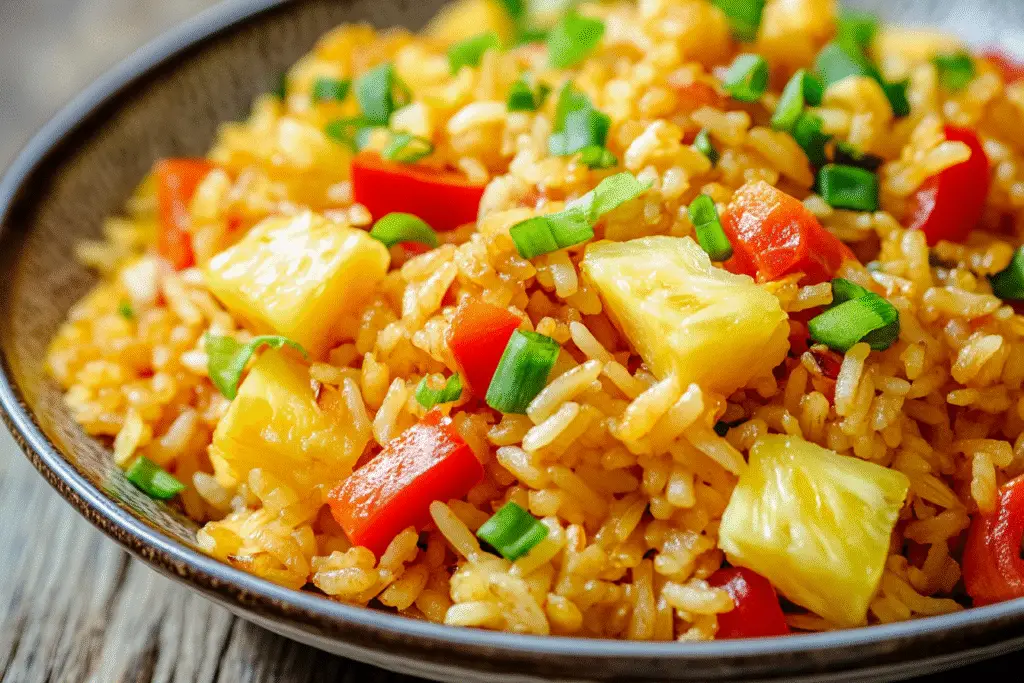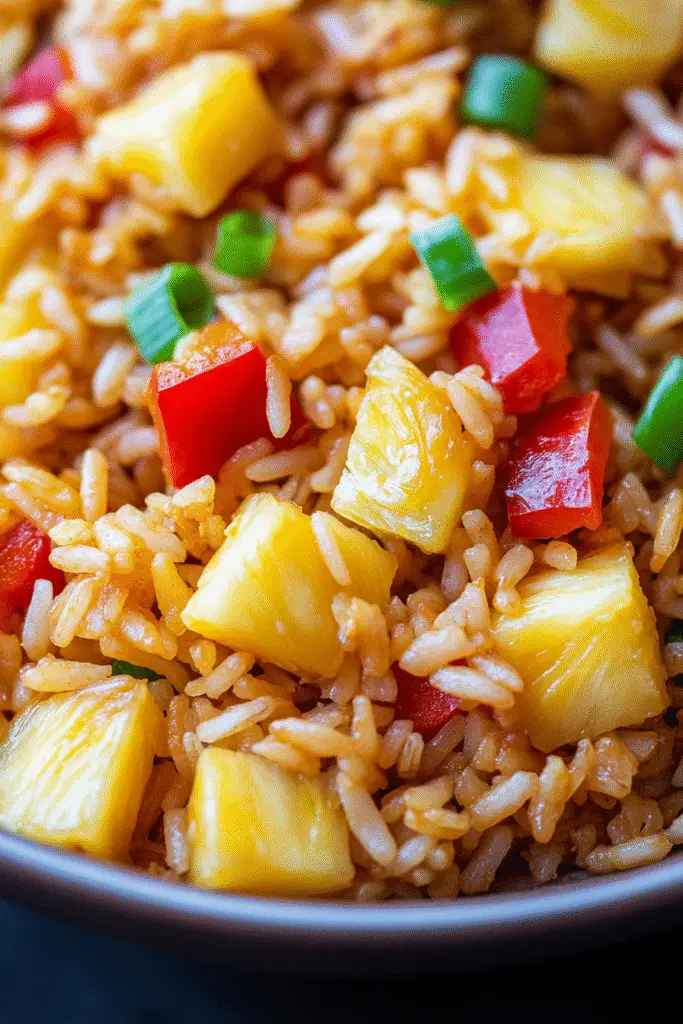Pineapple Fried Rice is a dish that effortlessly balances vibrant flavors and textures. It’s sweet from juicy pineapple, savory from soy sauce and garlic, crunchy from cashews or vegetables, and aromatic from curry powder and fresh herbs. While the dish is most famously associated with Thai cuisine, it’s beloved worldwide for its perfect harmony of taste, beautiful presentation—often served in a carved-out pineapple—and its incredible versatility.
Whether you’re preparing a quick weeknight meal or looking to wow guests with a stunning tropical dish, pineapple fried rice is the perfect choice. In this detailed guide, I’ll walk you through everything from selecting the right type of rice to achieving restaurant-style texture and balancing the complex sweet and savory flavors that make this dish unforgettable. We’ll cover troubleshooting, ingredient substitutions, variations, and even presentation tips to help you nail the iconic pineapple bowl look.
Why Pineapple Fried Rice Works: The Perfect Sweet and Savory Balance
The magic of pineapple fried rice lies in contrast and balance:
- Sweet: Fresh pineapple chunks add bursts of juicy sweetness.
- Savory: Soy sauce, garlic, and optional fish sauce or oyster sauce provide salty depth.
- Umami: Protein add-ins like shrimp or chicken elevate the flavor.
- Crunch: Cashews, bell peppers, and green onions offer essential texture.
- Spice: Optional chili flakes or fresh Thai chilies give the dish a subtle heat.
- Aroma: A dash of curry powder introduces the signature Thai-style fragrance.
Each bite offers a perfect mix of textures and tastes, making the dish feel light, flavorful, and satisfying.

Selecting the Best Rice: Texture Matters
Day-Old Rice is Essential
The secret to excellent fried rice is using cold, day-old rice.
- Freshly cooked rice is too moist and will turn mushy in the pan.
- Day-old rice is firmer, less sticky, and perfect for stir-frying.
Best Rice Varieties:
- Jasmine rice: Traditional in Thai cooking; it’s aromatic and holds up well.
- Long-grain rice: Works in a pinch but may lack the fragrance of jasmine.
If you must use fresh rice, spread it on a baking sheet and chill uncovered in the fridge for at least 30 minutes to dry it out.
Choosing Pineapple: Fresh vs. Canned
Fresh Pineapple:
- Best for this dish—juicy, sweet, and slightly tart.
- Offers better texture and presentation if serving in a pineapple bowl.
Canned Pineapple:
- Can be used in a pinch, but make sure to drain thoroughly and pat dry to avoid excess moisture in the dish.
Pro Tip:
Cut pineapple into bite-sized pieces to prevent large, soggy chunks that disrupt the rice’s texture.

Key Ingredients and Flavor Builders
Aromatics:
- Garlic: Classic base for depth.
- Onion and green onions: Add sweetness and freshness.
Sauces:
- Soy Sauce: Adds salt and umami.
- Oyster Sauce or Fish Sauce (Optional): For authentic depth.
- Curry Powder: Adds fragrance and light spice.
Crunch:
- Cashews or Roasted Peanuts: Provide essential crunch and a nutty flavor.
Proteins (Optional):
- Shrimp, chicken, or tofu all pair well.
Equipment Recommendations
Fried rice is best made quickly over high heat:
- Wok: Ideal for achieving that signature stir-fry texture.
- Large skillet: Works if you don’t have a wok.
- Wooden spatula or high-heat-safe spoon: For tossing the rice effectively.
Optional: A sharp chef’s knife for preparing a pineapple bowl.

Common Mistakes and How to Avoid Them
1. Soggy Rice
- Happens when using freshly cooked or overly wet rice.
- Solution: Always use day-old rice or chill fresh rice thoroughly.
2. Lack of Wok Hei (Aromatic Char)
- Caused by cooking at too low a heat or overcrowding the pan.
- Solution: Use high heat, cook in batches if necessary, and don’t stir constantly—allow rice to sit and lightly crisp in spots.
3. Overpowering Sweetness
- Adding too much pineapple or using syrupy canned pineapple can make the dish cloyingly sweet.
- Solution: Balance with soy sauce, a little acid (like lime juice), and optional chili flakes.
4. Underseasoned Rice
- Solution: Taste and adjust seasoning as you cook. Soy sauce alone may not be enough—consider fish sauce, curry powder, or additional salt.
Preparation Strategies for Seamless Cooking
Efficient Workflow:
- Prepare and measure all ingredients before heating the wok.
- Day-old rice should be broken up into small clumps before stir-frying.
- If adding proteins like shrimp or chicken, cook them first and set aside to avoid overcooking.
Make-Ahead Tips:
- Pineapple can be cut and prepped the day before.
- Sauce mixture (soy sauce, curry powder, optional fish sauce) can be combined in advance for quick assembly.
Flavor Variations and Customizations
Protein Options:
- Shrimp: Quick-cooking and classic in Thai versions.
- Chicken: Adds heartiness.
- Tofu: Perfect for vegetarian or vegan versions.
Heat Adjustments:
- Add Thai bird chilies for authentic spice.
- Use chili flakes or sriracha for a gentler kick.
Nut Choices:
- Cashews are traditional, but peanuts or almonds offer great texture too.
Vegetarian/Vegan Adaptation:
- Skip fish sauce and use soy sauce or tamari for a fully plant-based dish.
- Tofu or tempeh makes an excellent protein addition.
Ingredient List
For the Fried Rice:
- 3 cups (450 g) day-old cooked jasmine rice
- 2 tablespoons vegetable oil
- 3 cloves garlic, minced
- 1 small onion, diced
- 1 cup (150 g) fresh pineapple chunks
- ½ cup (75 g) red bell pepper, diced
- ½ cup (75 g) cooked shrimp or chicken (optional)
- 2 tablespoons soy sauce
- 1 tablespoon oyster sauce or fish sauce (optional)
- 1 teaspoon curry powder
- ½ teaspoon sugar (optional, adjust for sweetness)
- Salt and pepper to taste
- ¼ cup (30 g) roasted cashews or peanuts
- 2 green onions, sliced
For Garnish:
- Fresh cilantro or Thai basil
- Lime wedges
- Sliced red chili (optional)
Step-By-Step Instructions
1. Prepare All Ingredients
Ensure all ingredients are chopped, measured, and ready to go. Break up day-old rice into small clumps.
If using protein like shrimp or chicken, season lightly with salt and cook in the wok first until just done. Set aside.
2. Sauté Aromatics
Heat vegetable oil in a large wok or skillet over medium-high heat.
Add minced garlic and diced onion, stir-fry for 1-2 minutes until fragrant and slightly softened.
3. Add Pineapple and Vegetables
Stir in pineapple chunks and bell pepper. Cook for 2-3 minutes until pineapple is lightly caramelized and bell pepper is tender-crisp.
4. Incorporate Rice and Seasonings
Push vegetables to the side of the wok.
Add a bit more oil if needed, then add rice to the empty side. Let it sit for 30 seconds to toast slightly before stirring everything together.
Add soy sauce, oyster or fish sauce (if using), curry powder, sugar, salt, and pepper.
Toss well to coat all rice grains evenly.
5. Add Protein and Nuts
Return shrimp or chicken to the wok, stirring to combine.
Stir in cashews or peanuts and green onions.
Cook for another 2-3 minutes until heated through and fragrant.
6. Garnish and Serve
Serve hot, garnished with fresh cilantro, lime wedges, and optional sliced red chilies.
Optional: Serve in a carved-out pineapple bowl for a restaurant-style presentation.
Troubleshooting and FAQs
Can I use freshly cooked rice?
It’s not ideal, but if needed, spread hot rice on a baking sheet and refrigerate uncovered for at least 30 minutes to reduce moisture.
How do I cut a pineapple bowl?
Slice the pineapple in half lengthwise, cut around the inside edge, and cube the flesh to scoop it out, leaving enough shell for support.
Can I make this dish ahead?
It’s best fresh, but you can prep the ingredients in advance and stir-fry just before serving.
How should I store leftovers?
Store in an airtight container for up to 3 days. Reheat in a skillet over medium heat or in the microwave with a splash of water.
Variations: Classic, Protein-Packed, and Vegan Options
| Version | Protein | Sauce Base | Nuts | Notes |
|---|---|---|---|---|
| Classic | Shrimp | Soy, fish sauce | Cashews | Traditional Thai style |
| Chicken | Chicken breast | Soy, oyster sauce | Peanuts | Heartier flavor |
| Vegan | Tofu | Soy sauce | Cashews or peanuts | Fully plant-based |
| Spicy | Shrimp or chicken | Soy, fish sauce, chili | Cashews | For heat lovers |
Each version can be customized with vegetables like peas, carrots, or broccoli for extra texture.
Storage and Reheating Tips
- Storage: Refrigerate in an airtight container for up to 3 days.
- Reheating: Reheat in a hot skillet with a splash of water or in the microwave in short intervals, stirring in between.
- Freezing: Not recommended as the pineapple may become mushy after thawing.
Final Thoughts
Pineapple Fried Rice is a delightful balance of sweet, savory, and aromatic elements that’s both satisfying and visually striking. Whether you serve it in a pineapple bowl for extra flair or enjoy it straight from the skillet, this dish offers a quick, versatile, and endlessly customizable way to bring bold Thai-inspired flavors to your table.
Perfect for weeknight dinners, festive gatherings, or even meal prep, Pineapple Fried Rice is the kind of meal that invites creativity. I’d love to hear how you make it your own—whether you spice it up, keep it vegetarian, or add your favorite proteins!
